The best fertilizer spreader is at your fingertips with Linquip’s guide. With this post, we aim to provide you with a brief overview of fertilizer spreaders, a buying guide, and a list of the top options available.
The information you need about the fertilizer spreader is at Linquip, which is why you do not need to worry. In order to help you do your job more effectively, Linquip brings you the best fertilizer spreader available on the market. To learn more about what Linquip can offer you for your intended usage, take a look at our “What Is Agriculture?” page.
Would you like to purchase a fertilizer spreader for your needs? The Linquip website has an extensive database of Agriculture Products that you can search through for free in order to find the product you are looking for. If you are looking for the price of a fertilizer spreader, then Linquip can help you. Linquip lets you request free quotes from Agriculture Suppliers and Companies quickly, and you will receive them in a short time.
A fertilizer spreader is an excellent investment if you wish to maintain a healthy and attractive lawn or yard. The seemingly simple yet key drivers of excellent lawn care make sure fertilizers, compost, soil builders, seeds, and other lawn care products are evenly distributed throughout the lawn in the appropriate quantities for optimal plant health. You should choose a fertilizer spreader that is optimized for the terrain and size of your lawn and one that is easy to use.
How We Selected The Best Fertilizer Spreader in 2023?
At Linquip, selecting the 15 best fertilizer spreaders in 2023 was a meticulous and comprehensive process. We understand the importance of providing accurate and reliable information to our readers, so we undertook a thorough analysis that involved examining over 15 webpages, scouring through hundreds of products, and considering insights from various reviewers.
To ensure the utmost quality and expertise, we also consulted with our in-house experts who possess extensive knowledge and experience in the field of fertilizer spreaders. Their insights and recommendations played a pivotal role in our decision-making process, helping us identify the top performers in the market.
Our team delved deep into the specifications, features, and user feedback of each product. We compared their functionalities, durability, ease of use, and overall performance to assess their suitability for different applications and user preferences. Factors such as spreading capacity, coverage area, spread pattern control, and construction quality were thoroughly evaluated to determine the best options available.
Furthermore, we took into account our previous experiences with fertilizer spreaders and considered the feedback received from our readers to ensure that our selection aligns with real-world usage and customer satisfaction.
Through this rigorous selection process, we aimed to provide a well-rounded and reliable list of the 15 best fertilizer spreaders for 2023. Our objective was to present our readers with a comprehensive guide that assists them in making informed decisions based on their specific needs and requirements.
At Linquip, we remain committed to delivering accurate and trustworthy content, enabling our readers to make confident choices when it comes to selecting the right equipment for their fertilizer spreading needs.
Basics of Fertilizer Spreader
Using a fertilizer spreader, also called a lawn spreader or broadcast spreader, will save you time and ensure that fertilizer or seed is applied evenly and consistently. Additionally, it prevents people from coming into direct contact with fertilizers, chemicals, and lawn materials that would otherwise need to be handled by hand. The majority of fertilizer spreaders are also capable of spreading rock salt in the winter, making them useful all year long.
An important reason for using a fertilizer spreader is ensuring that packaged fertilizer is applied correctly. Too much fertilizer will burn and harm grass in a yard. Insufficient fertilizer will result in poor results, preventing the purpose of fertilizer from being fulfilled. A spreader is the only effective means of applying fertilizer correctly.
Fertilizer Spreader Types
Fertilizer spreaders come in five main types. Different types of these tools serve different purposes, so rather than assuming one is the best, think of them as ways to pick the right tool for the job.
Rotary Broadcast Spreaders
A rotary broadcast spreader is equipped with a distribution system that disperses fertilizer outward from the spreader as you push it along. There is an average distance between three and four feet at which fertilizer is launched by most spreaders. They are more suitable for larger areas due to their excellent coverage. For smaller lawns, rotary spreaders aren’t as effective since their range may cause the fertilizer to be thrown off.
Drop Spreaders
A drop spreader can be used instead of a rotary spreader in most situations. With these, fertilizer is dropped directly beneath the spreader, giving you exact control over where it goes. Those with mid-sized lawns and those who want more control over lawn fertilizer placement should consider drop spreaders.
Hand-Held Spreader
Small yards and gardens benefit from hand-held spreaders. Their capacity is lower than that of rotary and broadcast spreaders, and they don’t have much precision either, so they aren’t good choices if your lawn is large.
However, they’re ideal for planting in small greenhouses, along sidewalks, or gardens. It can also be used to fertilize steep slopes, where it is difficult to pull or push larger devices.
Walk-Behind Spreader
The term “walk-behind spreader” refers to any spreader you can push along. The majority of rotary, drop, and hand-held spreaders fall into this category.
A walk behind spread comes with the disadvantage of stepping on fresh fertilizer when you use it. If you use one of these, you should clean up before going inside so that you don’t carry fertilizer inside.
Tow-Behind Spreader
These spreaders attach to ride-on lawnmowers or ATVs. Generally, they are drop or rotary spreaders, but they are much larger and better at covering large areas than walk-behind spreaders. Tow-behind spreaders aren’t necessary for most households, but if you want to fertilize several acres, consider getting one.
Fertilizer Spreader Buying Guide
Here are the specific features to consider when choosing a fertilizer spreader and how to select one by taking into account the features available.
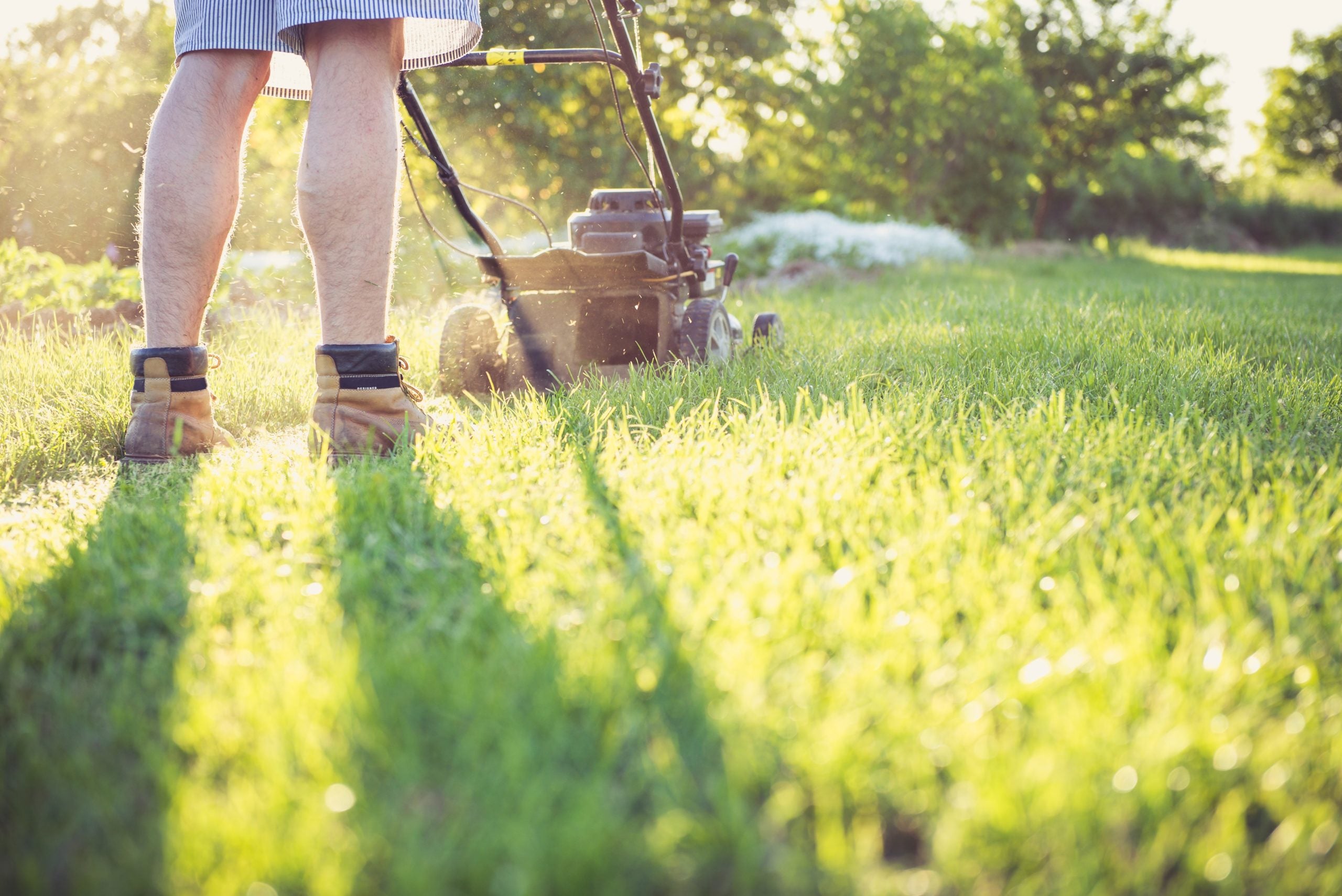
Operating Methods
The most widely used spreaders are the rotary broadcast spreaders and the drop spreaders. Handheld and tow-behind spreaders are meant for large or small yards, so average buyers may not be interested in them. You may want to consider a drop spreader if you aren’t sure which one to get. They provide greater control over where fertilizer goes, making the process easier for many.
Spreader Size and Weight
Weight may not be a big problem unless you are using hand-held spreaders since they will need to be pushed, pulled, and towed. On the other hand, if you are considering buying a hand-held spreader, make sure it is light enough to move around without tiring you. It’s also crucial to consider the weight of the product being fed, which, combined with the spreader’s weight, you should be able to carry relatively easily. You can use that as an indicator of the best hand-held spreaders, which have a weight of fewer than 10 pounds.
Material
Invest in a spreader made of durable, strong material. Steel and stainless steel are popular choices due to their hardiness. Choose a material that will withstand harsh conditions since the spreader will be used exclusively outdoors. Stainless steel is an ideally suited material for this type of application.
If you choose steel, make sure it has been treated against corrosion and rust. Maintaining it regularly will ensure that it stays in top condition for years to come.
Plastic frames may wear out over time, especially if used frequently in the summer. A variety of engineered plastics are highly durable and can withstand extreme temperatures and other elements.
Corrosive Resistant
Spreaders should have corrosion resistance. Even without water, fertilizer can be corrosive, so you should keep spreaders in a dry area when not in use. A better choice is something that is resistant to chemical reactions.
Capacity
What is the maximum capacity of the hopper? Distributing products over a large area requires infrequent refills, which is why a large hopper is ideal. Small hoppers are suitable for spreading products in small lawns. For small and medium-sized lawns, a hopper with a capacity of 30-50 pounds is sufficient. If you need a hopper for large or commercial settings, look for one with a capacity of 120+ lbs.
Durability
In addition to the materials used to construct the spreader, the quality of the workmanship also plays a crucial role. Make sure the spreader you choose is solidly constructed and made from durable materials. Ideally, these should last ten years or more.
Spreading
It is important that you select a fertilizer spreader that is appropriate for the terrain in order to ensure that fertilizer and other products are evenly spread. Only this method will give your farm, lawn, or yard a uniform appearance. Using the wrong spreader will cause some parts of the land to get more product than others, and this will be evident as soon as the plants sprout and grow.
Wheels
In a spreader, wheels play an important role by supporting the main body of the equipment. In the case of poorly designed wheels, they will only be able to provide a weak level of support. Ensure your spreader has wide, well-balanced tires to provide excellent support and stability.
Accessories
Spreaders do not require many accessories to increase their user-friendliness. A hopper cover, however, is widely recognized as an accessory. Its purpose is to protect inside materials against humidity, rain, snow, and other forms of moisture, thereby preserving their quality. In addition, chemical dust and chemical particles are trapped inside the hopper, preventing you from inhaling chemical dust and coming into contact with chemical compounds.
Warranty
Warranty coverage on the best fertilizer spreaders should be at least five years. There are also exceptional ones that come with a limited lifetime warranty. The majority of warranties last one year, but some only cover you for three months. If you are planning to spend a lot of money on a spreader, make sure it has an extended warranty so you can get the support you deserve.
Best Fertilizer Spreader Reviews
10 Best Fertilizer Spreader include:
- Scotts Turf Builder EdgeGuard Mini Spreader
- Agri-Fab Push Broadcast Spreader
- Lesco High Wheel Fertilizer Spreader
- Earthway 2150 50 LB Commercial Broadcast Fertilizer Spreader
- Chapin 8620B 150 lb Tow Behind Spreader
- Amaze Broadcaster For Seed Or Fertilizer
- JRCO Electric Broadcast Spreader
- Scotts Elite Fertilizer Spreader
- Scotts Whirl Hand-Powered Spreader
- Scotts Wizz Hand-Held Fertilizer Spreader
A variety of spreader types and styles are included in our list of the best fertilizer spreaders, ensuring that most buyers will find an option that suits their needs. Among a wide range of models available on the market, we chose those that had the best spread capacity, holding capacity, precision, and operation method. See our top suggestions for the best commercial fertilizer spreaders below, based on feedback from customers.
1. Scotts Turf Builder EdgeGuard Mini Spreader
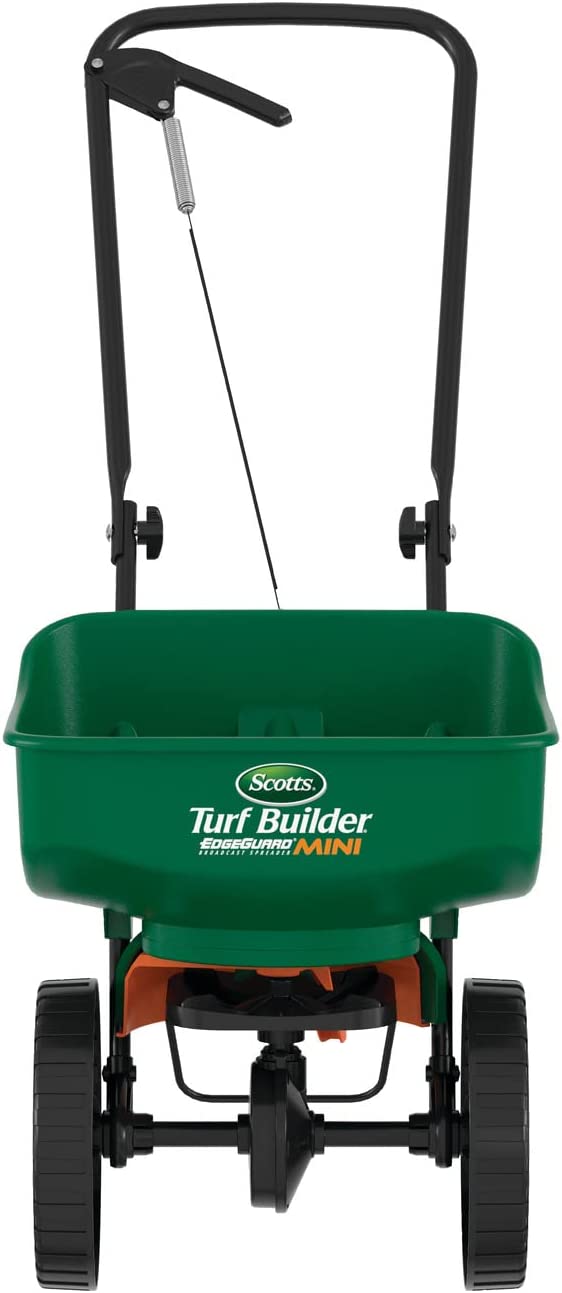
Specifications
| Weight | 1 pounds |
| Dimensions | 16 x 20 x 45.25 inches |
| Capacity | 25 pounds |
| Type | Walk-behind, rotary |
Thanks to its fold-down handle, this 1-pound Scotts Turf Builder EdgeGuard Mini Broadcast Spreader, which measures 16 by 20 by 45.25 inches, is small, lightweight, and easy to store in limited spaces. With its capacity of 5,000 square feet of lawn materials, it is suitable for yards up to 10,000 square feet.
To ensure more accurate coverage, users can adjust the precision rate settings on the control panel. In order to prevent lawn treatment from being spread across sidewalks or flower beds, EdgeGuard is designed to block coverage on the right side of the spreader.
With its hard plastic wheels, this lightweight spreader does not require assembly. Besides being affordable, it is calibrated as well. For easy storage, the handles fold down when not in use. Compared to air tires, skinny hard wheels did not roll as smoothly over uneven terrain. Static also causes the final bits of product to stick to the spreader’s bottom.
2. Agri-Fab Push Broadcast Spreader
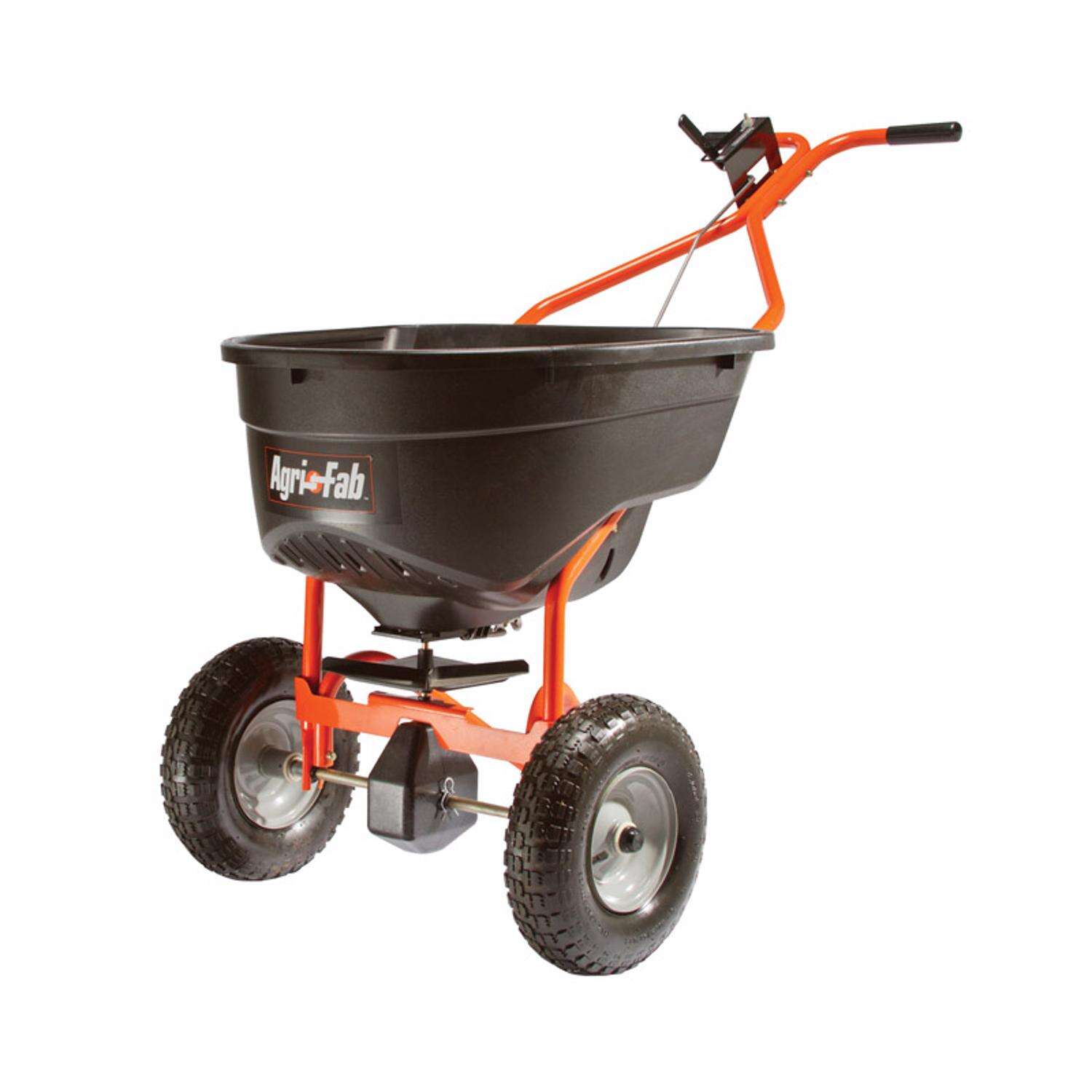
Specifications
| Weight | 35 pounds |
| Dimensions | 48 x 27.1 x 33.6 inches |
| Capacity | 130 pounds |
| Type | Walk-behind |
There are a number of companies worth looking into in the agricultural business, in addition to Scotts. There are a lot of great products made by Agri-Fab, including this broadcast spreader. With the 360-degree spreader on the Agri-Fab unit, you don’t have to do as much backtracking as you would with a traditional spreader.
It’s a little tricky to use this unit. While walking, it will throw fertilizer toward your legs as it spreads both forward and behind. If you wear the right shoes, that isn’t that big a deal, but it does result in slightly uneven application.
In spite of that drawback, the rapid coverage of this spreader still makes it worth considering. The 25,000-square-foot rated area makes it an excellent choice for larger yards. It covers up to twelve feet at a time.
This product can be purchased with an optional deflector kit to allow fertilizer to be spread more efficiently. Because it has so much power, angling things in a better manner solves its only real weakness.
3. Lesco High Wheel Fertilizer Spreader
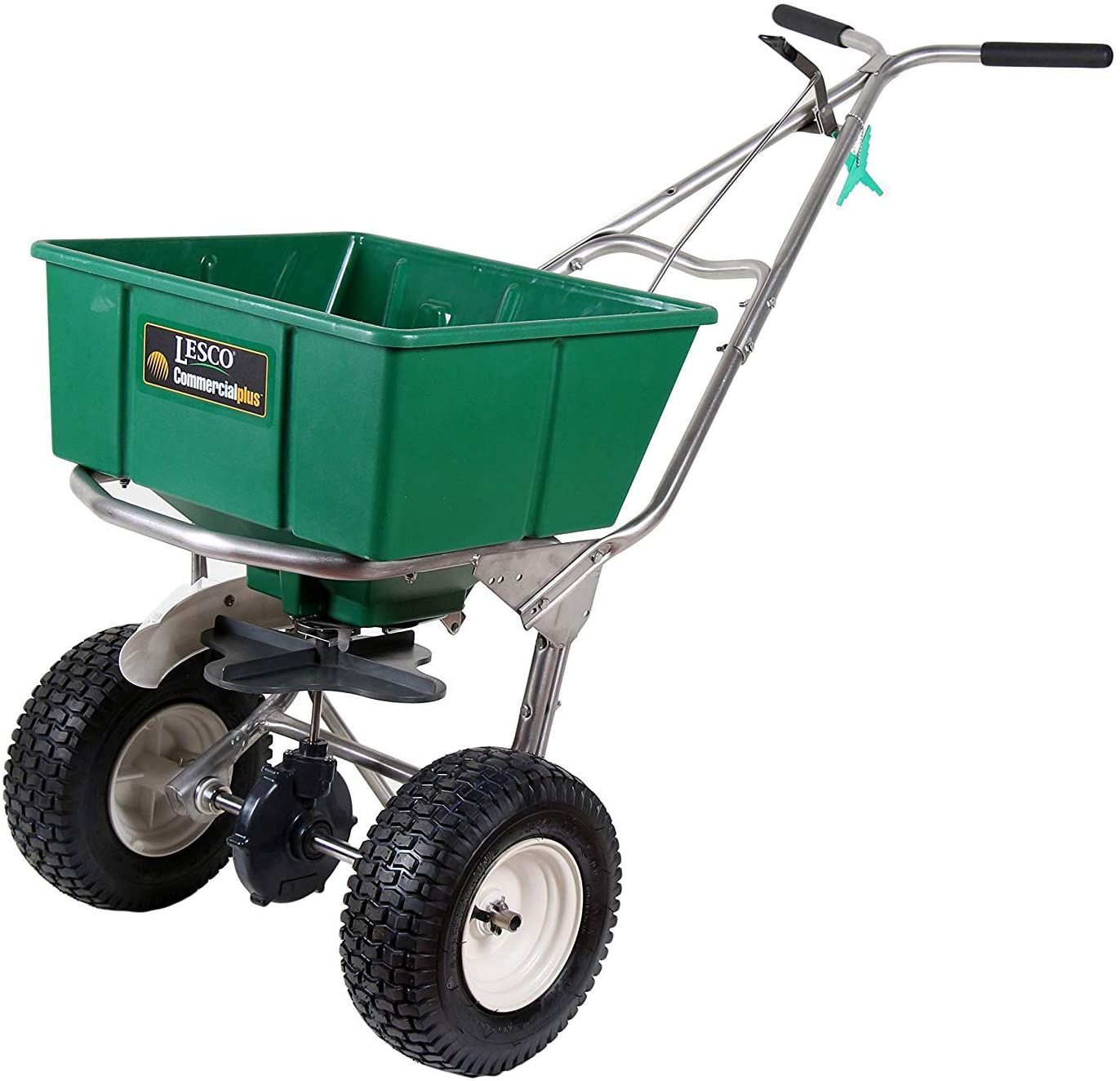
Specifications
| Weight | 44.1 pounds |
| Dimensions | 25.79 x 22.99 x 20.98 inches |
| Capacity | 80 pounds |
Lesco’s 101186 has a stainless steel frame that ensures durability, easy maintenance, and a rust-free appearance over time, even for outdoor use. You never have to worry about the spreader tipping over because its oversized tires roll with ease and ensure stability in any terrain. In order to ensure its longevity, the gear set is fully enclosed to keep debris and rust away.
The 80-pound hopper ensures an adequate supply of product and reduces the number of times you have to refill it. For those with a large or medium lawn, this can be quite helpful. This lawn fertilizer spreader is one of the best available today because it offers uniform product distribution with a gear ratio of 5:1. In addition, it comes with a manual deflector kit that prevents the product from spreading beyond its intended area. In order to enhance product flow and preserve the product coating, a cam-operated oscillating agitator is used in the dispensing mechanism.
There are three different positions for the handles, making them adjustable to fit various users’ heights.
In its empty state, the spreader weighs 42 pounds, which makes it a bit heavy. Since the spreading machine was designed as a heavy-duty fertilizer spreader, it shouldn’t come as much of a surprise. Also, it shouldn’t be a problem since no lifting is required.
4. Earthway 2150 50 LB Commercial Broadcast Fertilizer Spreader
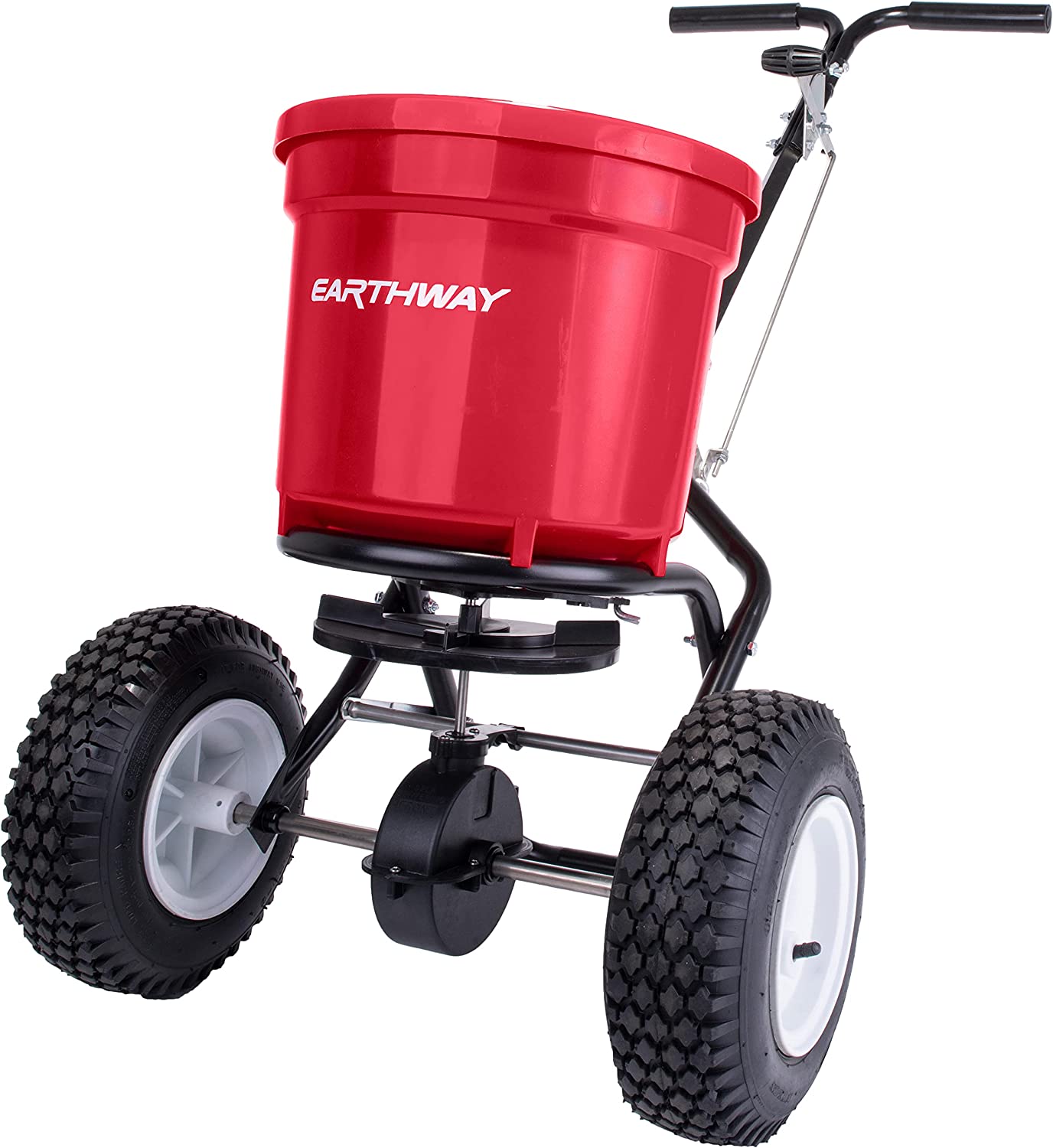
Specifications
| Weight | 27 pounds |
| Dimensions | 15.75 x 14.5 x 23.63 inches |
| Capacity | 50 pounds |
| Type | Walk-behind, rotary |
With dimensions of 15.75 by 14.5 by 23.63 inches, this Earthway 50-pound walk-behind broadcast spreader can handle a wide variety of tasks. With the heavy-duty plastic hopper, you can manage yards ranging from 10,000 square feet to an acre. The height adjustment handle can be adjusted in two positions, and the T-speed lever ensures excellent control and comfort for all users. An even spread pattern is provided by the three-hole drop shutoff system. Also, a feathered spread edge facilitates smooth application.
In order to ensure durability under rugged operation conditions, such as uneven terrain, the frame is designed to support a load of 175 pounds. Long-lasting durability and smooth operation are ensured by 13-inch stud tires mounted on rustproof poly-made rims. Super-duty, commercial-grade gearbox withstands years of use. For this spreader, users can expect to spend a few hours assembling and calibrating it.
The experiences of users showed the ease of assembly instructions and robust components of this product. In conclusion, this spreader has a number of advantages, such as its durability, ease of operation, and comfort while using it.
5. Chapin 8620B 150 lb Tow Behind Spreader
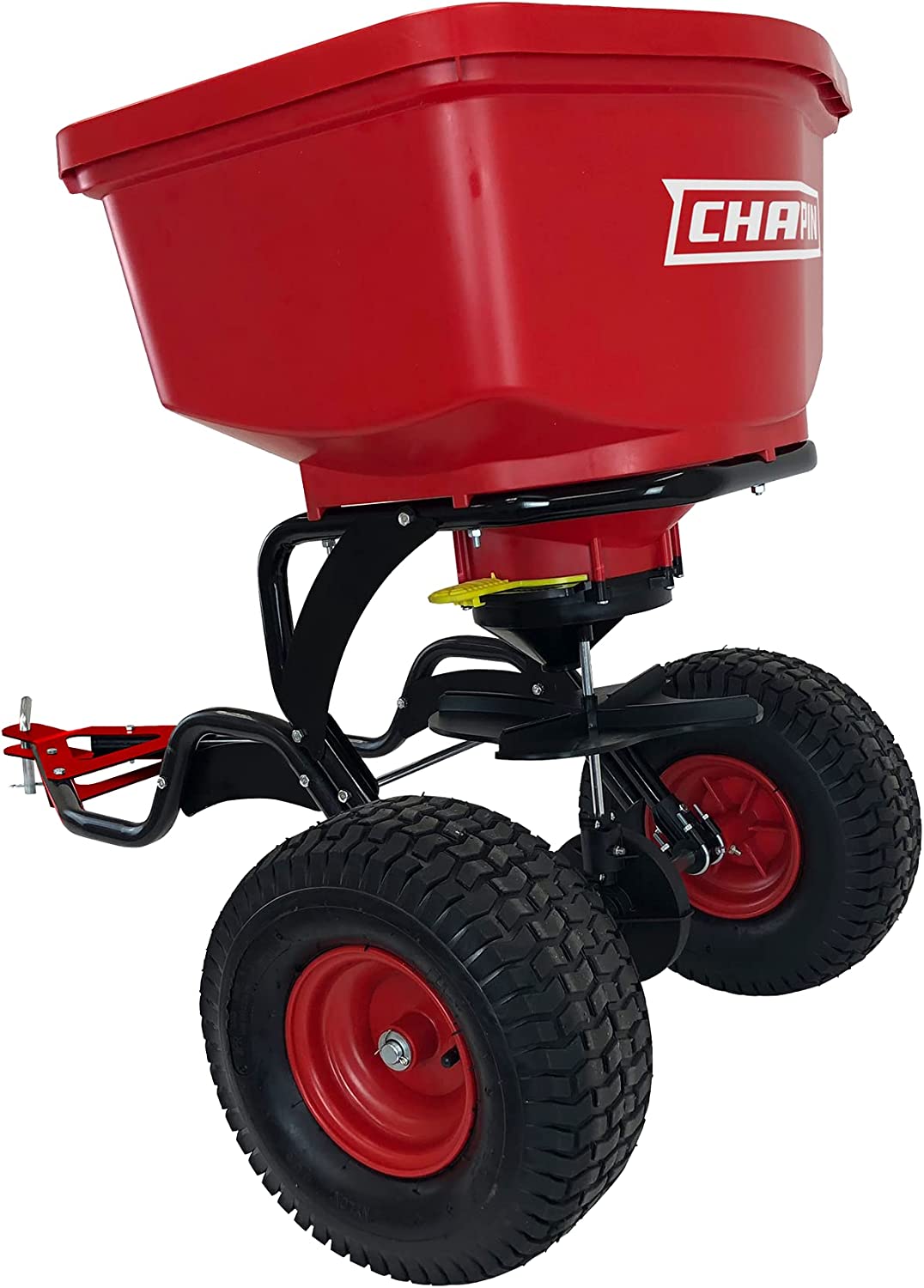
Specifications
| Weight | 40.7 pounds |
| Dimensions | 26 x 36 x 36 inches |
| Capacity | 150 pounds |
| Type | Tow behind spreader |
This Chapin International 8620B spreader is regarded as one of the best farm fertilizer spreaders by most farm care enthusiasts after testing it out. The heavy, powder-coated steel frame conveys a feeling of strength and durability. With its heavy-duty, wide tread 14″ pneumatic tires, this vehicle is capable of moving over all types of terrain.
Due to its large 150-lb hopper, it is one of the best fertilizer spreaders for commercial/professional use at this price point. There is no better fertilizer spreader in its class when you consider the 11 gate adjustment incremental settings, which provide a wide range of width settings. The gate adjustment can be set to zero in order to tow a fertilizer spreader without dispensing the product. By doing this, the gate will stay closed until it is reset.
A dual impeller mechanism in the spreader allows the product to pass only when the spreader is in motion. Upon stopping the spreader, an auto-stop feature kicks in. In this way, you will have less to do and will waste less product.
With its heavy-duty trailer hitch, it can be easily attached to a lawn tractor or other vehicle for use in large areas and the professional field. In addition to this, a lifetime limited warranty is included with this product.
6. Amaze Broadcaster For Seed Or Fertilizer
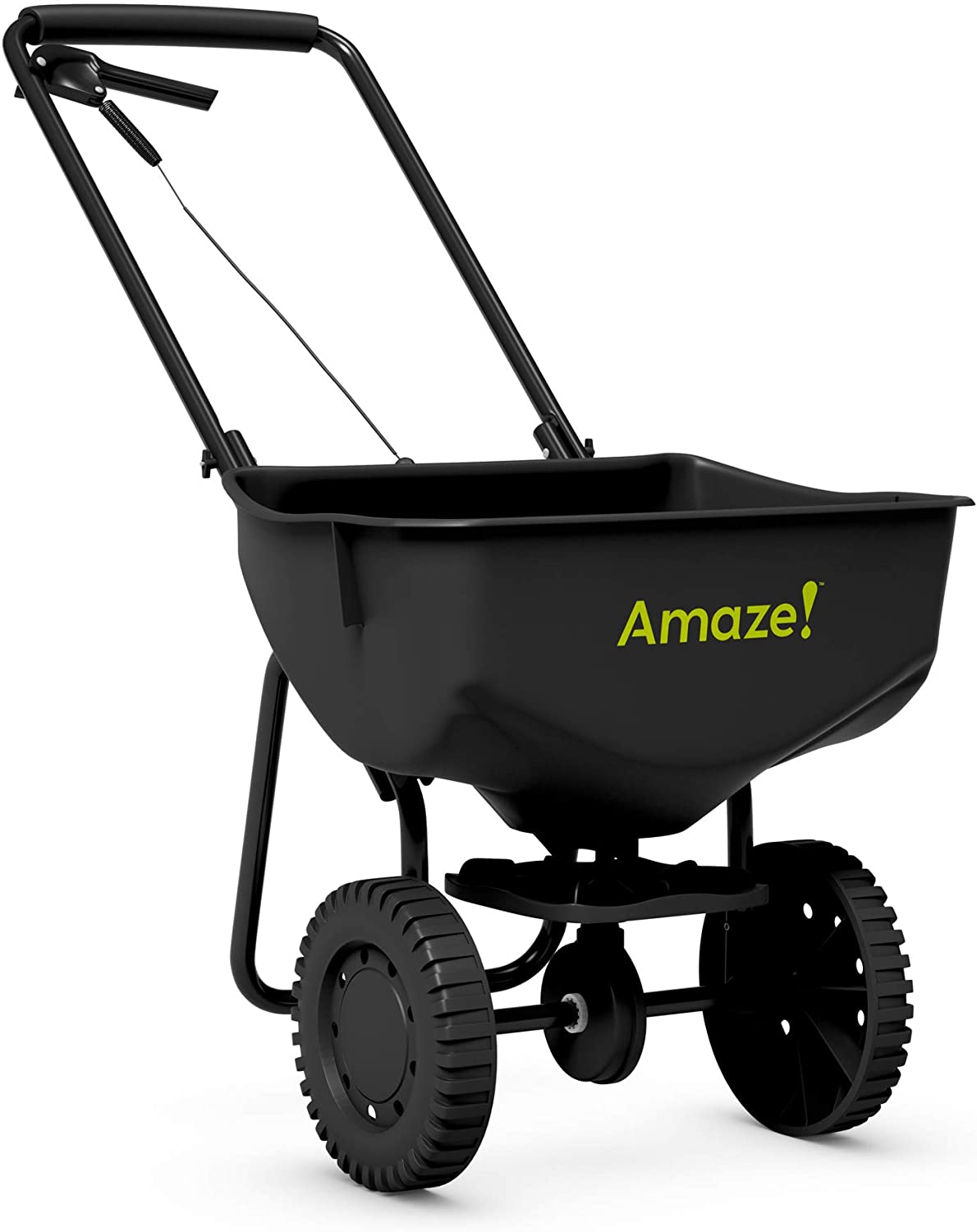
Specifications
| Weight | 12.27 pounds |
| Dimensions | 20.5 x 20.75 x 21 inches |
| Capacity | 10,000 square feet |
| Type | Walk-behind rotary |
The Amaze spreader is an excellent backup spreader. It is enough to cover the average yard size in many states, making this a suitable size for most people. You don’t have to carry extra fertilizer bags or refill your spreader for that reason alone.
The system on Amaze’s spreader also sets it apart from the crowd. In contrast to other spreaders, which are typically flat, this one is specifically curved. With this design, fertilizer is thrown upward instead of straight out, giving you greater control over the fertilizer’s final destination.
Compared to other fertilizer spreaders, this one applies fertilizer evenly and won’t leave streaks on the lawn, as you might see with others. There may not be as much durability with this spreader as with some other products, but it should at least last several years.
This is an excellent backup option that can work with most products.
7. JRCO Electric Broadcast Spreader
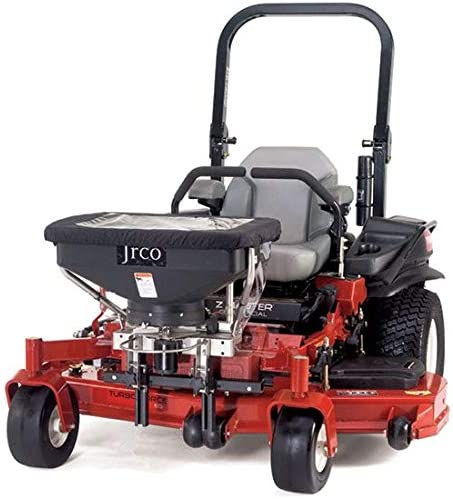
Specifications
| Weight | 50 pounds |
| Dimensions | 48 x 48 x 48 inches |
| Capacity | 150 pounds |
| Frame | stainless steel |
JRCO’s 150-lb Electric Broadcast Spreader uses a sealed heavy-duty, direct drive, 12V electric motor, along with a bumper made of stainless steel that protects the motor and fan from damage. A sealed wire harness connects the spreader’s motor to the battery of the mower or utility vehicle you hitched it to. A JRCO mounting bar is required to attach the unit to mid-mount utility vehicles. When you purchase the fertilizer spreader from JRCO, the bar is not included, so you will need to purchase it separately.
Hands-free operation of zero-turn mowers or utility vehicles is possible with the foot-operated stainless steel gate. This gate is designed to be non-gumming so that it can be easily opened and closed. An electronic speed control ensures uniform feeding and maintains a spread pattern width between 5 and 24 feet.
The non-sensitive parts of this spreader are made of engineered plastics, and the frame is made of stainless steel. Because of its sturdy construction and durable materials, it will last a good number of years without corroding.
There are a variety of optional features, such as a lump-sifting screen, a side deflector kit, and an extension wire harness to make operating the speed control easier.
Considering the spreader’s price tag, its warranty is excessively short – only 90 days.
8. Scotts Elite Fertilizer Spreader
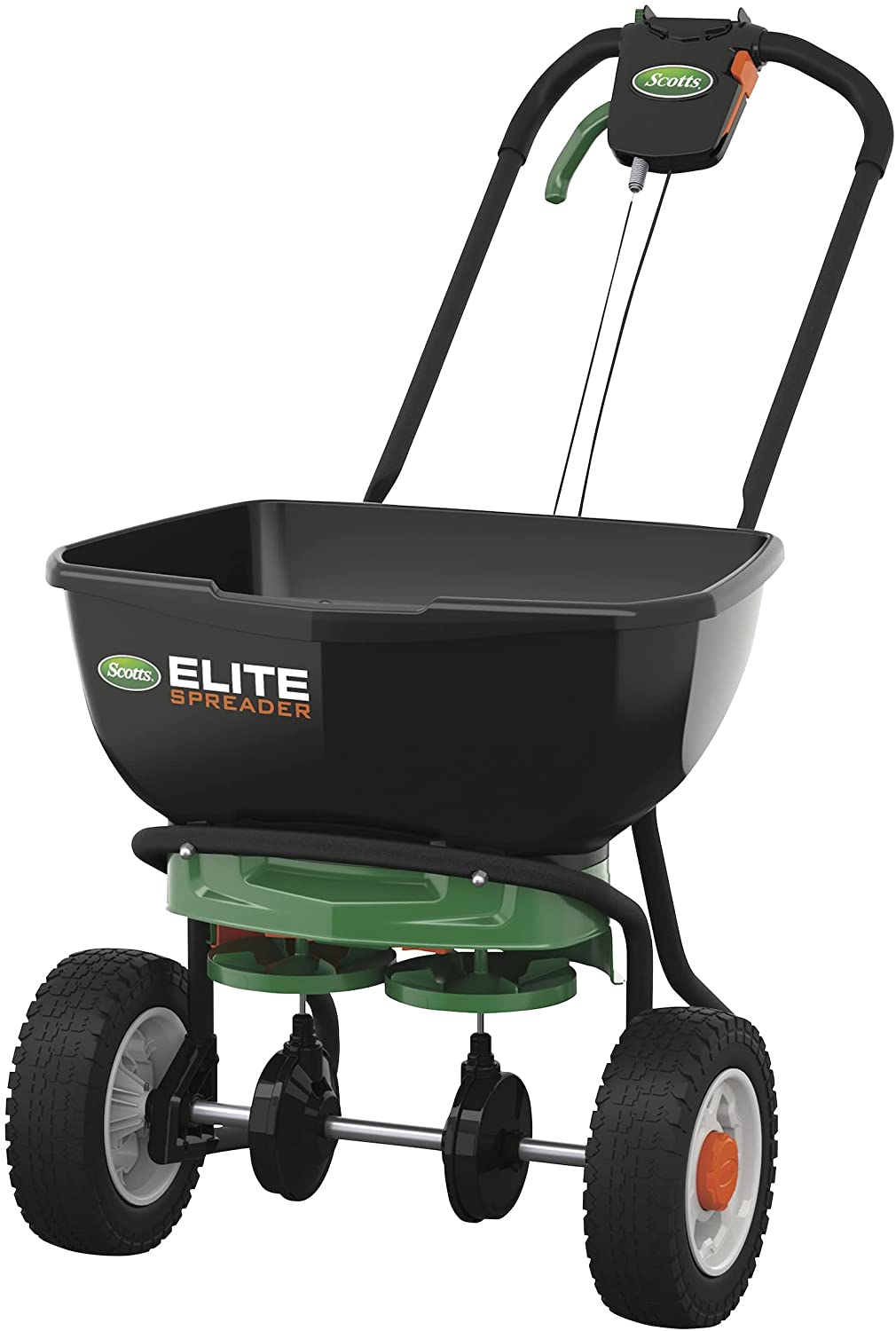
Specifications
| Weight | 19.75 pounds |
| Dimensions | 23.31 x 23.63 x 20.07 inches |
| Capacity | 60 pounds |
| Type | Walk-behind dual rotary |
Scotts’ Elite spreader is one of their newest products, and it differs significantly from the company’s traditional style. One of the most apparent changes is the switch to a dual-rotary system. As a result, fertilizer is spread more evenly over the six-foot spread pattern, which is better for lawns. Also nice are the better plastic tires.
An added feature is a smartphone holder at the top of the spreader. As a result, you can keep your eyes on a yard map, listen to music, and use your electronic devices while you’re fertilizing your lawn. While it is a nice idea, it is not as useful as it appears since the glare from the sun can obscure the screen, making it difficult to read.
Almost any lawn can be covered by this spreader, as it covers an area of up to 20,000 square feet. The main disadvantage of it is that it can’t cover a vast area at once like many other spreaders. For this reason, it takes longer to use. Despite an otherwise excellent spreader system, that is an unfortunate drawback. Meanwhile, it improves precision by having a narrower range.
This spreader also has a downside in terms of cost. While the price of this spreader is significantly higher than that of most other spreaders, its coverage area and precision make it a great investment for commercial users.
9. Scotts Whirl Hand-Powered Spreader
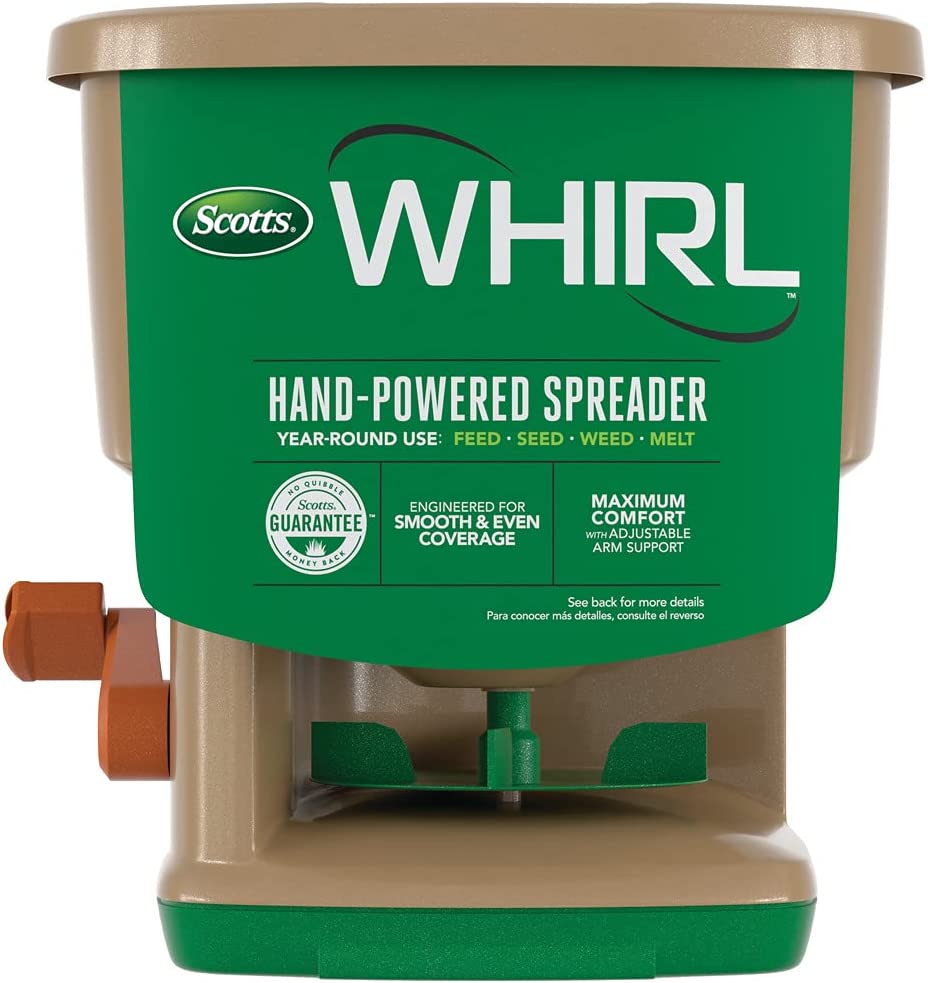
Specifications
| Weight | 1.15 pounds |
| Dimensions | 13.1 x 8.7 x 8.5 inches |
| Capacity | 2 pounds |
| Type | Handheld, rotary |
With the Scotts Whirl Hand-Powered Spreader, small yards can take care of their lawns all year long. Despite its small size, it is durable and easy to store, measuring just 13.1 by 8.7 by 8.5 inches and weighing just over a pound. Due to its plastic construction, property owners can spread fertilizer, ice melt, and other products freely, without worrying about corroding their spreaders like they would with metal ones.
Due to its small storage space and ease of use, this spreader is a big hit with many users. The hopper can be filled, the trigger squeezed, and the handle rotated to operate the machine. The opening width is adjustable, and the trigger opens the hopper gate as the baseplate crank turns to release the material. Slide-out wrist supports assist in steadying the hopper and reduce operator fatigue. The tool could be used to seed bare spots in the grass, spread ice-melt products in difficult-to-reach areas, and treat small areas with grass seed.
10. Scotts Wizz Hand-Held Fertilizer Spreader
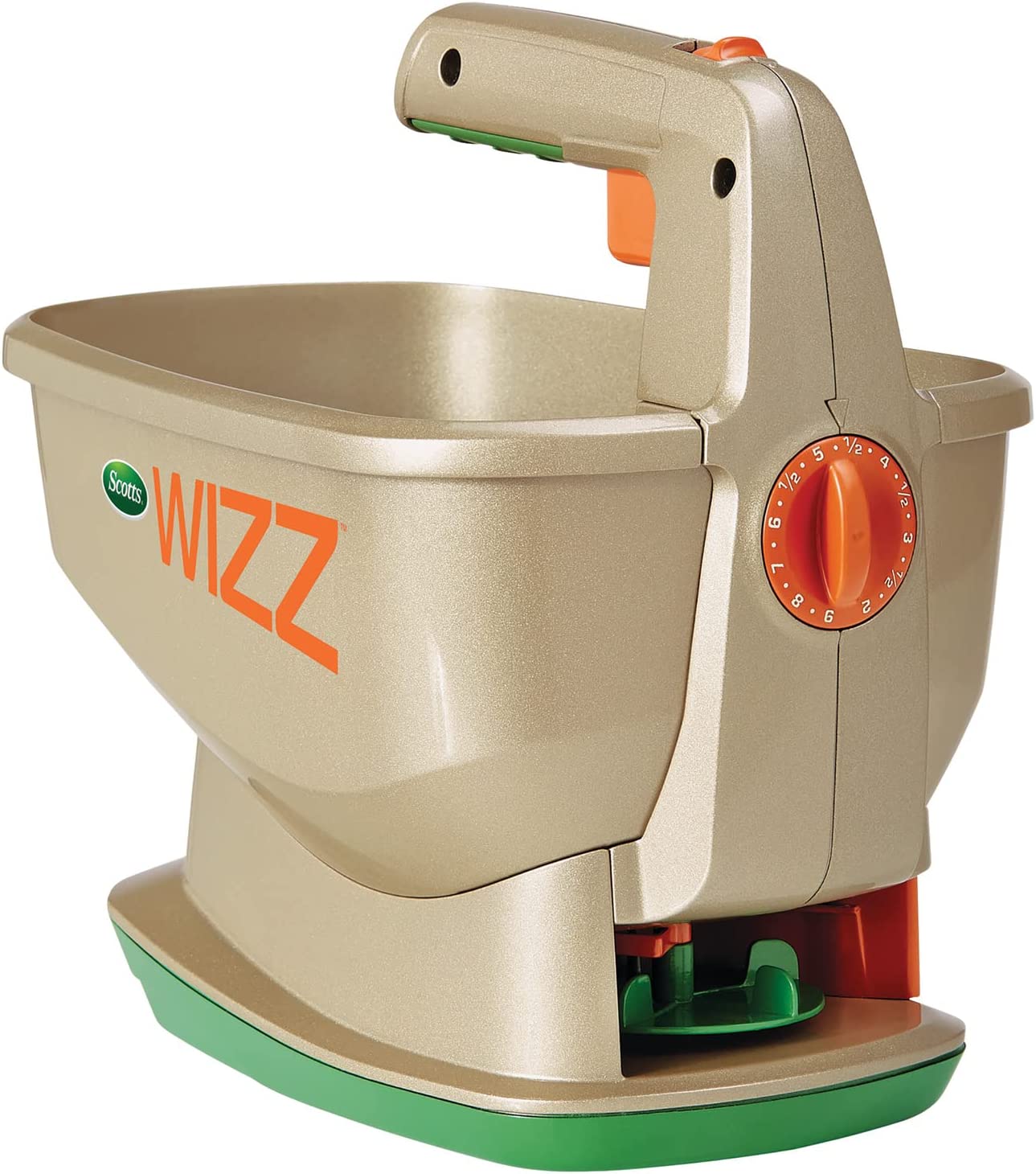
Specifications
| Weight | 2.1 pounds |
| Dimensions | 23.25 x 7.75 x 19.25 inches |
| Capacity | 2500 square feet |
| Type | Handheld, rotary |
This battery-powered spreader is a rare find. With its consistency, this motor may be a good choice for those who need something that can cover a large lawn. To use this spreader properly, you must walk at a steady pace, so it’s not suitable for people who can only move a little at a time.
Spreading distances of about five feet are achievable with the Wizz, and 23 settings give you greater flexibility over how much is distributed. There is, however, an unusually narrow spread to this tool. A 180-degree angle is typical for fertilizer spreaders, but this unit has a 120-degree angle. It’s a good thing there’s a slider on one side to control the angle more easily.
There is a drawback to this product: forgetting about the batteries is easy. Although lithium-ion batteries won’t drain as quickly as older styles, all batteries self-discharge over time. The batteries will probably drain completely after two or three uses per season and keep the Wizz in your garage during the winter.
With regular battery changes and charging, the Wizz provides accurate and efficient fertilizer application.
11. Tomahawk Broadcast Spreader
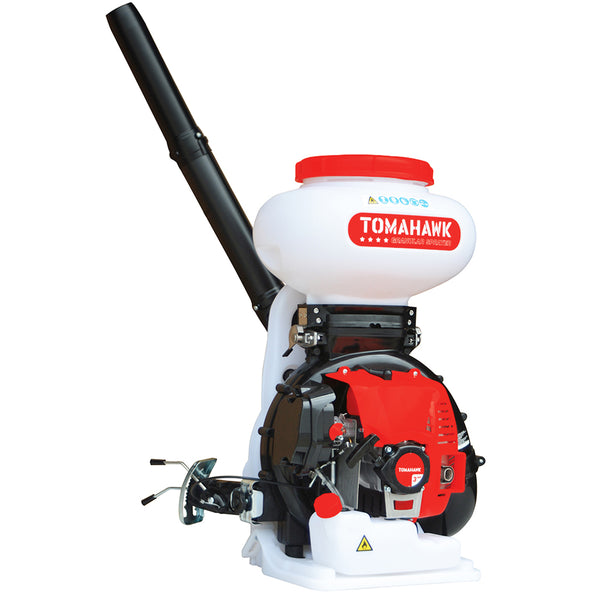
Specifications
| Hopper capacity | 2.5 gallons |
| Spreading width | 10-18 feet |
| Application rate | 0.5-4 pounds per 1,000 square feet |
| Weight | 6 pounds |
General Description
The Tomahawk Broadcast Spreader is a hand-powered spreader that is easy to use. It has a simple dial that allows you to adjust the application rate, and it is lightweight enough to carry and maneuver easily. The hopper is small, so it is not ideal for large yards, but it is perfect for small yards or for spot-treating specific areas.
Overall, the Tomahawk Broadcast Spreader is a versatile and easy-to-use spreader that is perfect for small yards or for spot-treating specific areas. It is not ideal for large yards, but it is a great value for the price.
12. Chapin 2000 Hand-Powered Drop Spreader

Specifications
| Hopper capacity | 1.6 gallons |
| Spreading width | 10-12 feet |
| Application rate | 0.5-4 pounds per 1,000 square feet |
| Weight | 4 pounds |
General Description
The Chapin 2000 Hand-Powered Drop Spreader is a simple and affordable spreader that is perfect for small yards or for spot-treating specific areas. It is easy to use and adjust, and it is made of durable materials.
The Chapin 2000 Hand-Powered Drop Spreader is a simple and easy-to-use spreader that is perfect for small yards or for spot-treating specific areas. It has a small hopper, so it is not ideal for large yards, but it is a great value for the price.
13. Scotts Turf Builder Classic Drop Spreader
Specifications
| Hopper capacity | 10,000 square feet |
| Spreading width | 10-12 feet |
| Application rate | 0.5-4 pounds per 1,000 square feet |
| Weight | 5 pounds |
General Description
The Scotts Turf Builder Classic Drop Spreader is a popular and affordable spreader that is perfect for small to medium-sized yards. It is easy to use and adjust, and it is made of durable materials.
The Scotts Turf Builder Classic Drop Spreader is a simple and easy-to-use spreader that is perfect for small to medium-sized yards. It has a large hopper, so it can hold enough material to fertilize a large yard, but it may take a long time to do so. It is not as precise as some other spreaders, but it is a great value for the price.
14. Brinly 40-Inch Tow Behind Aerator Spreader
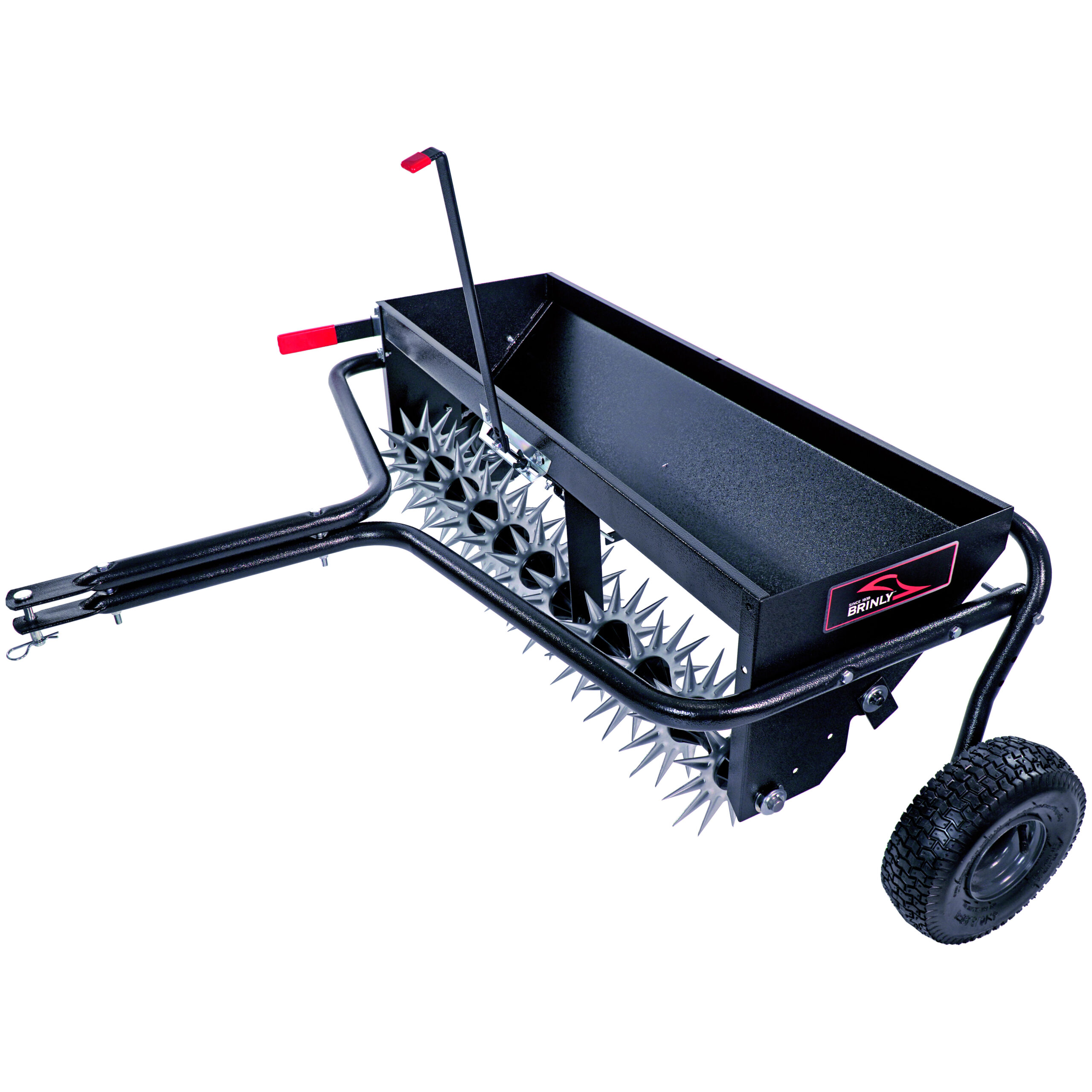
Specifications
| Hopper capacity | 100 pounds |
| Spreading width | 40 inches |
| Application rate | 0.5-4 pounds per 1,000 square feet |
| Weight | 130 pounds |
General Description
The Brinly 40-Inch Tow Behind Aerator Spreader is a versatile tool that can be used to aerate and fertilize your lawn. It is a tow-behind spreader, so you will need a lawn tractor or other power source to use it.
The Brinly 40-Inch Tow Behind Aerator Spreader is a great option for those who want a versatile spreader that can be used to aerate and fertilize their lawn. It is a bit expensive, but it is made of durable materials and can withstand the elements. It is not ideal for small yards, but it is a great option for those with medium to large lawns.
15. Greenworks 40-Inch Tow Behind Spreader

Specifications
| Hopper capacity | 70 pounds |
| Spreading width | 40 inches |
| Application rate | 0.5-4 pounds per 1,000 square feet |
| Weight | 90 pounds |
General Description
The Greenworks 40-Inch Tow Behind Spreader is a battery-powered spreader that is perfect for medium to large lawns. It is easy to use and maneuver, and it can cover a lot of ground quickly.
The Greenworks 40-Inch Tow Behind Spreader is a great option for those who want a battery-powered spreader that is easy to use and maneuver. It is a bit expensive, but it is made of durable materials and can withstand the elements. It is not ideal for small yards, but it is a great option for those with medium to large lawns.
Download the Best Fertilizer Spreader PDF
You can download the article in PDF format if that would be more convenient for you. The file can be downloaded by clicking on the following link.
Buy Equipment or Ask for a Service
By using Linquip RFQ Service, you can expect to receive quotations from various suppliers across multiple industries and regions.
Click Here to Request a Quotation From Suppliers and Service Provider
Read More In Linquip
- 10 Best Steel Toe Boots for Women (Clear Guide)
- Top Fastener Suppliers & Manufacturing
- Foam Rubber Suppliers in USA & Worldwide
- Crushed Stone Suppliers in USA: The Best guide
- The 4 Best Ceramic Coatings: A Clear Guide
- Warehouse Equipment Products
- 10 Best CNC Machines & Routers for WoodWorking (Clear Guide)
- 8 Best Rust Converter (Ultimate Guide)
- The 10 Best Glues for Metal + Tips for Choosing
- The 9 Best Commercial Patio Heaters + Buying Guide



